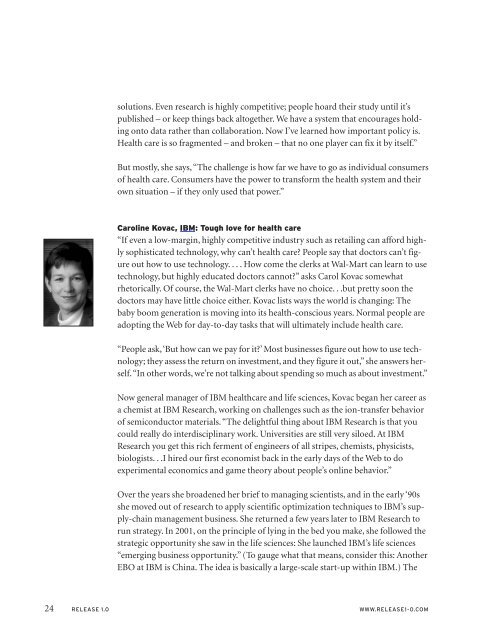The World Wide World: IT Ain't Just the Web ... - Cdn.oreilly.com
The World Wide World: IT Ain't Just the Web ... - Cdn.oreilly.com
The World Wide World: IT Ain't Just the Web ... - Cdn.oreilly.com
You also want an ePaper? Increase the reach of your titles
YUMPU automatically turns print PDFs into web optimized ePapers that Google loves.
solutions. Even research is highly <strong>com</strong>petitive; people hoard <strong>the</strong>ir study until it’s<br />
published – or keep things back altoge<strong>the</strong>r. We have a system that encourages holding<br />
onto data ra<strong>the</strong>r than collaboration. Now I’ve learned how important policy is.<br />
Health care is so fragmented – and broken – that no one player can fix it by itself.”<br />
But mostly, she says, “<strong>The</strong> challenge is how far we have to go as individual consumers<br />
of health care. Consumers have <strong>the</strong> power to transform <strong>the</strong> health system and <strong>the</strong>ir<br />
own situation – if <strong>the</strong>y only used that power.”<br />
Caroline Kovac, IBM: Tough love for health care<br />
“If even a low-margin, highly <strong>com</strong>petitive industry such as retailing can afford highly<br />
sophisticated technology, why can’t health care? People say that doctors can’t figure<br />
out how to use technology....How <strong>com</strong>e <strong>the</strong> clerks at Wal-Mart can learn to use<br />
technology, but highly educated doctors cannot?” asks Carol Kovac somewhat<br />
rhetorically. Of course, <strong>the</strong> Wal-Mart clerks have no choice. . .but pretty soon <strong>the</strong><br />
doctors may have little choice ei<strong>the</strong>r. Kovac lists ways <strong>the</strong> world is changing: <strong>The</strong><br />
baby boom generation is moving into its health-conscious years. Normal people are<br />
adopting <strong>the</strong> <strong>Web</strong> for day-to-day tasks that will ultimately include health care.<br />
“People ask,‘But how can we pay for it?’ Most businesses figure out how to use technology;<br />
<strong>the</strong>y assess <strong>the</strong> return on investment, and <strong>the</strong>y figure it out,” she answers herself.“In<br />
o<strong>the</strong>r words, we’re not talking about spending so much as about investment.”<br />
Now general manager of IBM healthcare and life sciences, Kovac began her career as<br />
a chemist at IBM Research, working on challenges such as <strong>the</strong> ion-transfer behavior<br />
of semiconductor materials. “<strong>The</strong> delightful thing about IBM Research is that you<br />
could really do interdisciplinary work. Universities are still very siloed. At IBM<br />
Research you get this rich ferment of engineers of all stripes, chemists, physicists,<br />
biologists. . .I hired our first economist back in <strong>the</strong> early days of <strong>the</strong> <strong>Web</strong> to do<br />
experimental economics and game <strong>the</strong>ory about people’s online behavior.”<br />
Over <strong>the</strong> years she broadened her brief to managing scientists, and in <strong>the</strong> early ‘90s<br />
she moved out of research to apply scientific optimization techniques to IBM’s supply-chain<br />
management business. She returned a few years later to IBM Research to<br />
run strategy. In 2001, on <strong>the</strong> principle of lying in <strong>the</strong> bed you make, she followed <strong>the</strong><br />
strategic opportunity she saw in <strong>the</strong> life sciences: She launched IBM’s life sciences<br />
“emerging business opportunity.” (To gauge what that means, consider this: Ano<strong>the</strong>r<br />
EBO at IBM is China. <strong>The</strong> idea is basically a large-scale start-up within IBM.) <strong>The</strong><br />
24 RELEASE 1.0 WWW.RELEASE1-0.COM
















